Pieris care and growing guide – expert tips on how to grow a dazzling andromeda bush
Find out how to grow pieris, and add lively interest to pots and borders with this vibrant flowering evergreen shrub

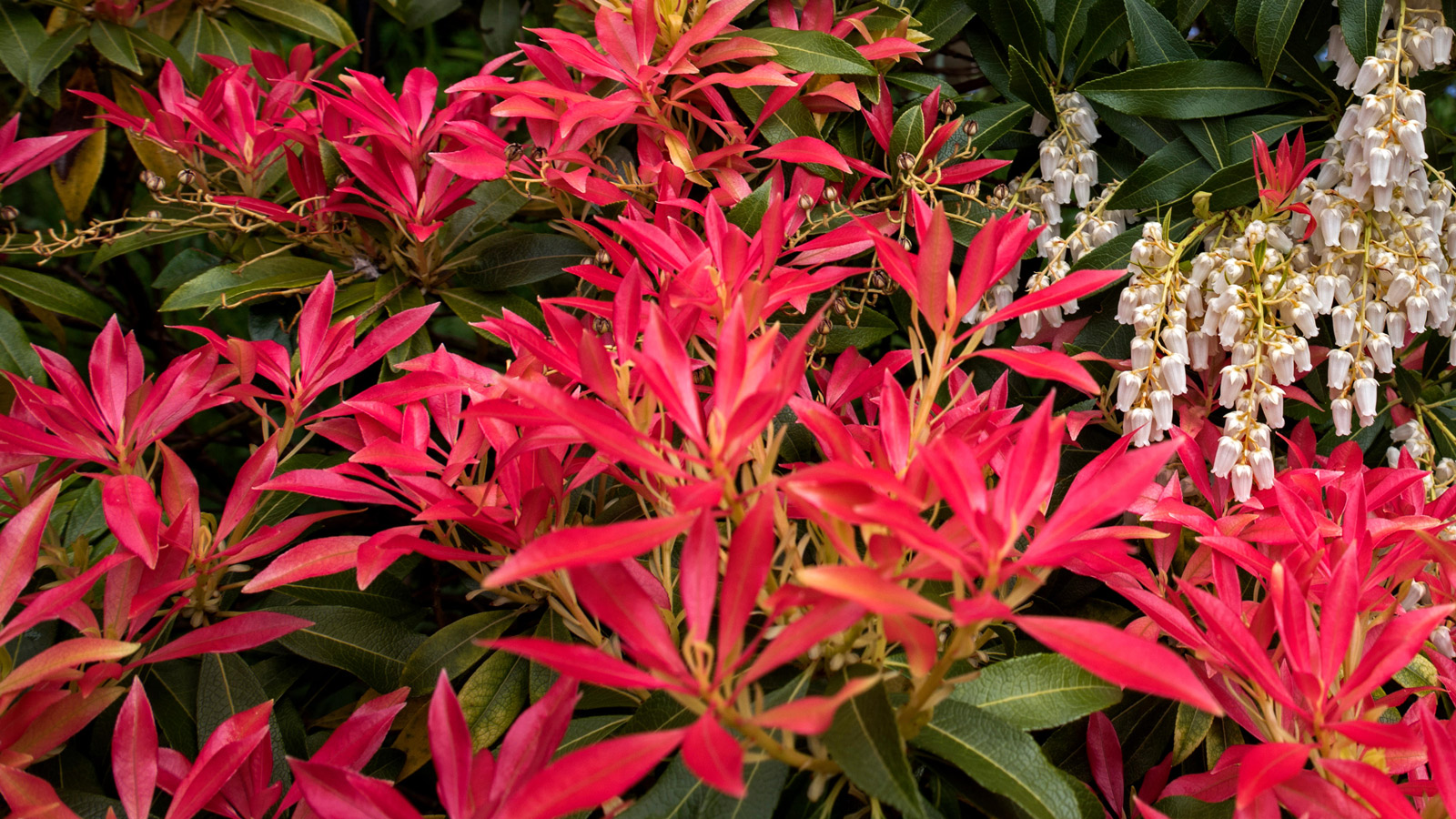
Pieris are easy-to-grow and cold-hardy evergreen shrubs with dark fingered foliage that is attractive all year round. This plant (also known as the andromeda bush or the lily-of-the-valley bush) develops into well branched and well furnished shrubs with two lovely colorful features.
In winter and early spring, all pieris develop branched clusters of buds, the red-tinted varieties being especially pretty. In spring, buds open to nodding flowers, like lily-of-the-valley. At the same time, many varieties of pieris feature new growth that is bright red or richly bronzed, often emerging at the same time as the flowers, creating a striking spring picture.
Pieris are easy to grow and adaptable evergreen shrubs – all they need is lime-free soil. If you can grow rhododendrons, you can certainly grow pieris. They look fabulous in mixed borders, contemporary plots, dramatic flower beds and well positioned patio plantings. And in areas with unsuitable soils, pieris grow perfectly well in containers.
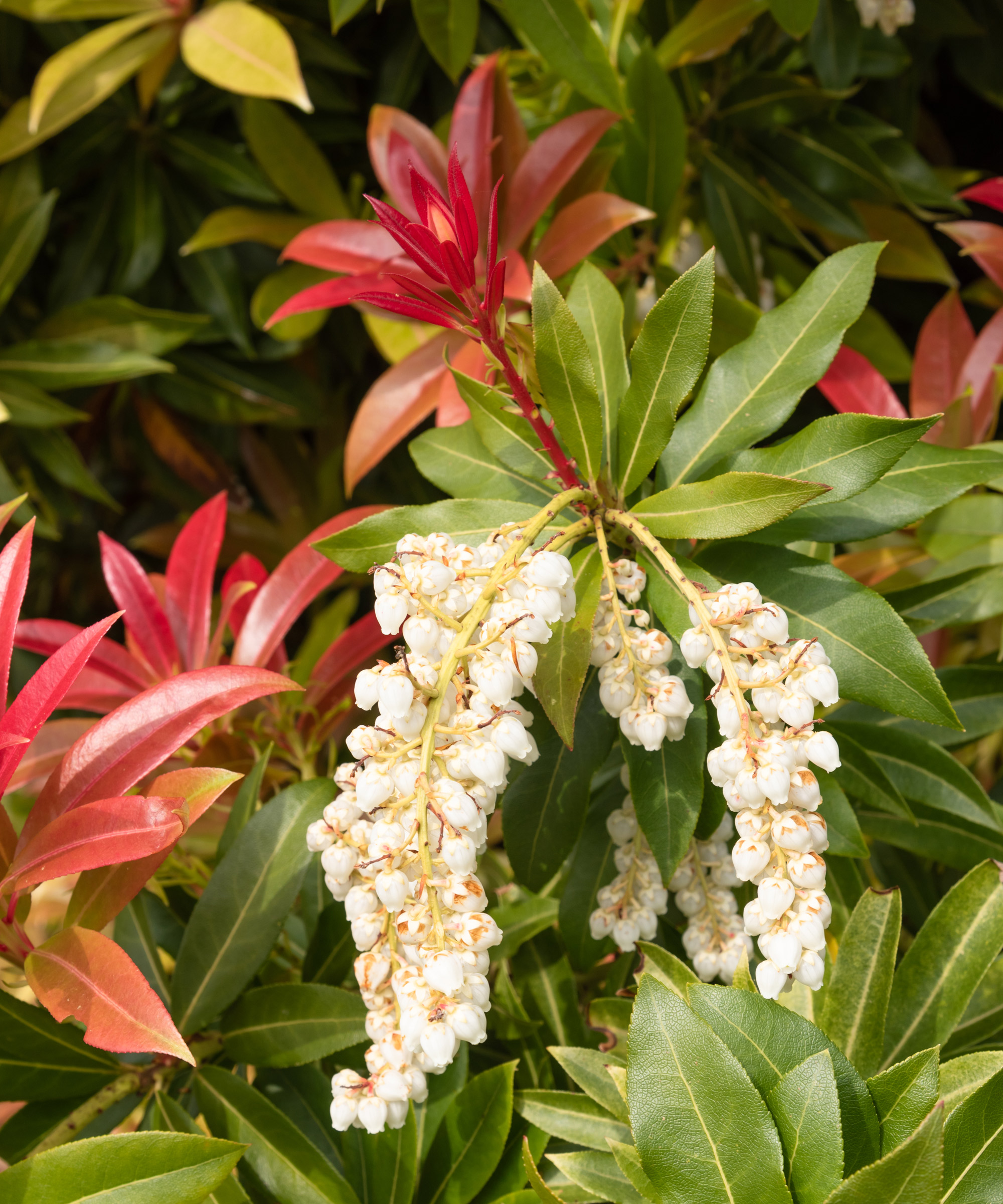
Pieris ‘Wakehurst’ is a great performer, with flowers and red foliage emerging at the same time
Pieris key facts
- Plant type: Evergreen flowering shrub
- Mature size: 3-6ft
- Soil type: Well-drained soils
- Soil PH: Slightly acid or acid
- Time of year to plant: Spring, fall
- Flowering time: Spring
- Flower color: White, pink, red
- Hardiness zones: USDA Z5-9
- Scientific name: Pieris
- Common name: Andromeda bush, lily-of-the-valley bush, Japanese pieris, mountain pieris
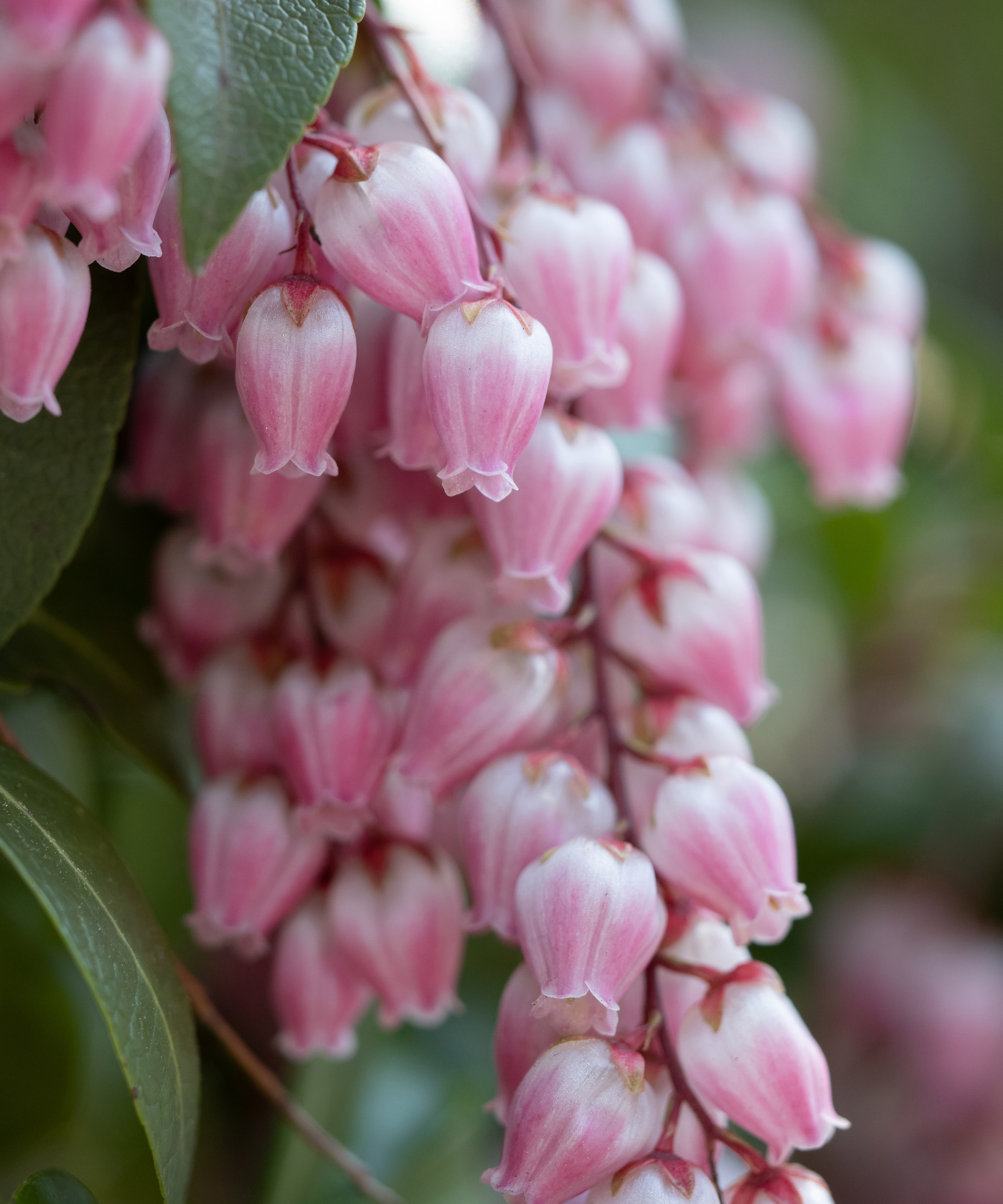
As well as white blooms, there are also varieties with pink tinted bells
Identifying the main types of pieris
Pieris are some of the best flowering shrubs you can choose if you want to add a spot of drama, either in groups or as specimen plants. 'In March and April, plants drip with elegant panicles of bell-shaped flowers that range in color from snow-white to dark rose-red,' say the experts at the Broken Arrow Nursery in Connecticut.
Pieris fall into two groups – defined not so much by the way they look but as a result of their origins.
- Native pieris (fetterbush): Native in the east, Pieris floribunda is an attractive but slow-growing evergreen and its foliage provides food for native moth caterpillars. It shows resistance to the lacebug, which is a problem on other pieris. White spring flowers are held upright, or slightly pendulous, helping distinguish it from the Japanese pieris with flowers that hang down. It has an unusual vining relative, the climbing fetterbush (P. phillyreifolia), native to the extreme south east but rarely seen in gardens.
- Japanese pieris: Often grouped as Japanese pieris, two Asian species – P. formosa and P. japonica – are more widely grown. For those after low-maintenance garden border ideas, these shrubs feature larger flower clusters than the native fetterbush, with red, copper or bronze growth that emerges as the flowers open. However, just bear in mind that Japanese pieris are increasingly troubled by lacebugs, an introduced pest.
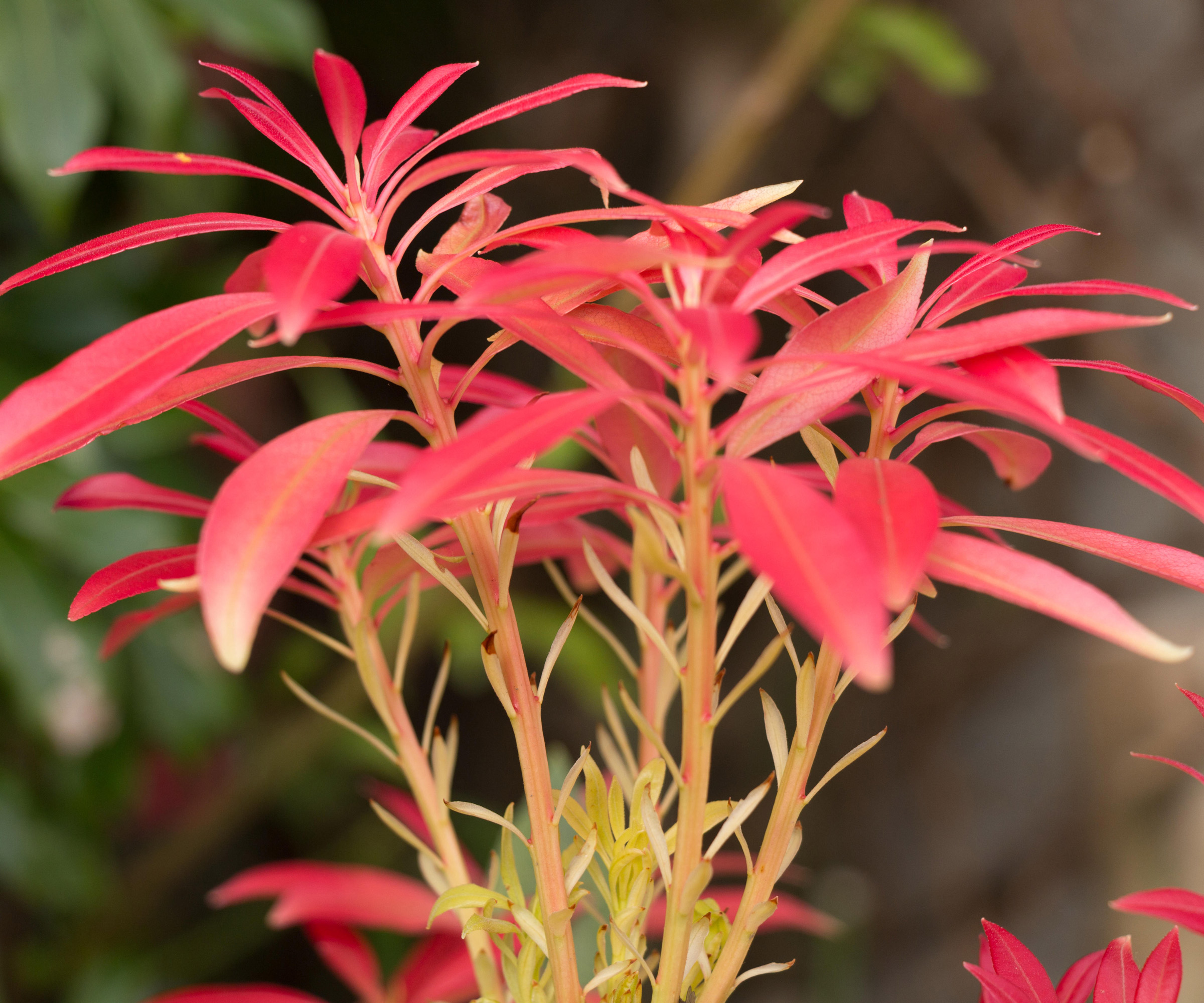
Pieris japonica ‘Mountain Fire’ has glorious new growth
Choosing the right pieris for your yard
Most pieris develop branched spring sprays of white flowers and look like lily-of-the-valley. However, some varieties work well with vibrant garden color schemes, developing flowers that are pale pink, rich pink or vivid red.
Pink and red-flowered andromeda bushes grow in the same way as the white ones and need the same treatment. Red ‘Interstellar’, rich pink ‘Enchanted Forest Gay Goblin’ (‘Cabernet’) from Monrovia, and pink and white ‘Valley Rose’ are excellent options. Just consider if you are growing pieris for flowers or foliage, garden borders or pots.
Design expertise in your inbox – from inspiring decorating ideas and beautiful celebrity homes to practical gardening advice and shopping round-ups.
- Pieris for the garden: For the most dramatic display, choose varieties of Pieris formosa or P. japonica, combining colorful blooms and bright new foliage. ‘Wakehurst’ has shining white flowers and bright red new leaves. Many varieties of P. japonica, including ‘Valley Valentine’ from Monrovia with its reddish pink flowers, also feature coppery new growth.
- Pieris for containers: Pieris make excellent options for container gardening in areas where garden soil is unsuitable. ‘Flaming Silver’ (available from Nature Hills) has year-round variegated foliage, white flowers and red new growth. ‘Passion Party Pink Frost’ (‘Opstal 10’) from Monrovia has creamy variegated foliage, pale pink flowers and two-tone reddish new shoots. White flowered ‘Cavatine’ is shorter than most. Fill your container with a lime-free potting mix.
- Pieris for flowers: The pieris with the largest, most showy flower clusters are deep red ‘Interstellar’, rosy red ‘Valley Valentine’, pink ‘Enchanted Forest Impish Elf’ (‘Shy’) from Monrovia, white ‘Purity’ from Monrovia and generous white ‘Southern Lady’.
- Pieris for foliage: For pieris with colorful new spring shoots at flowering time, consider ‘Mountain Fire’ from Nature Hills, which is red turning chestnut, and brilliant red ‘Forest Flame’. For variegated foliage, try compact ‘Little Heath’ available from Etsy and ‘Flaming Silver’ from Nature Hills Nursery, which has red young shoots plus variegated foliage.
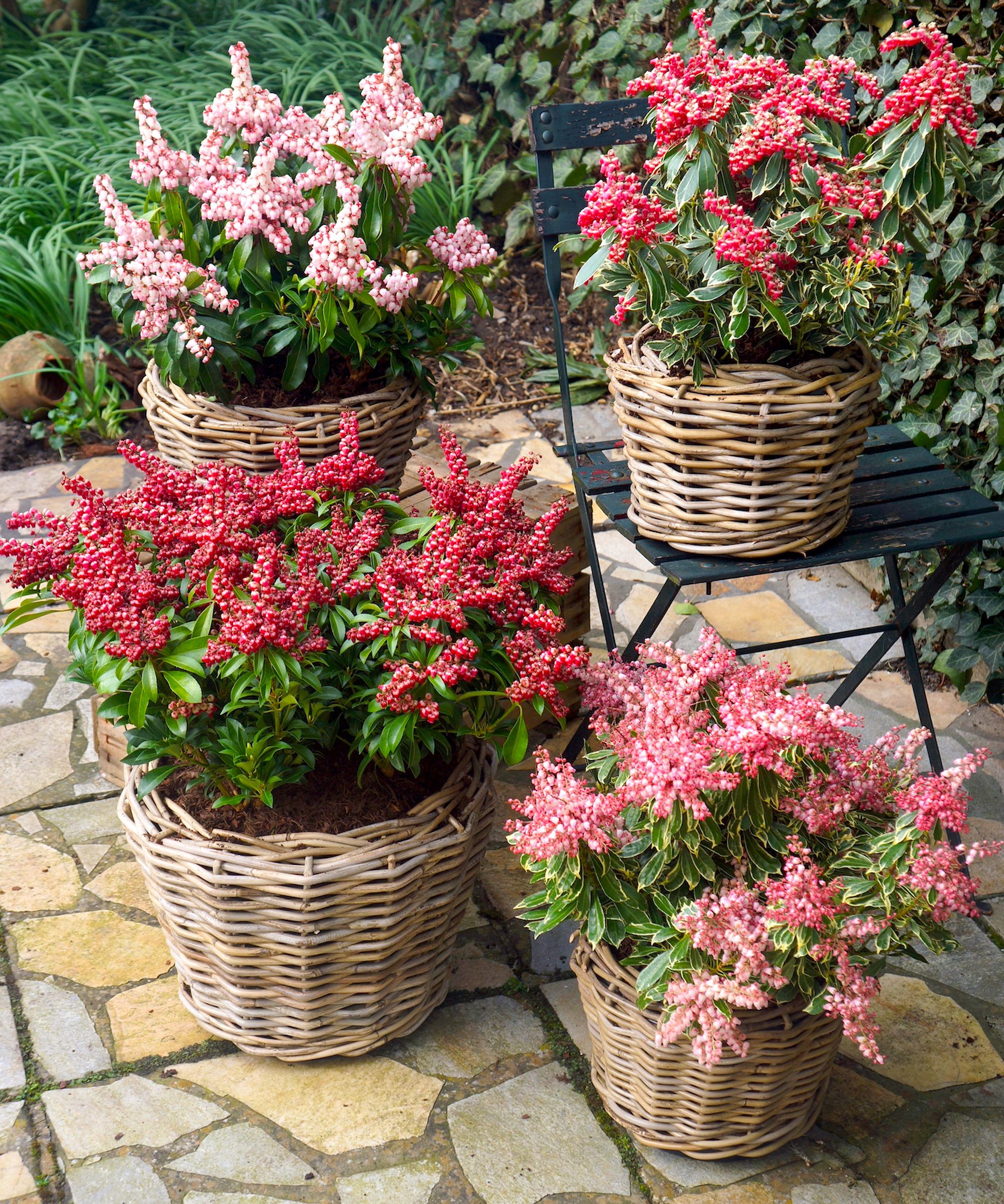
If you don’t have acid soil, grow pieris like ‘Passion’ in pots
Where, when and how to plant pieris
If you want to know how to grow pieris, the good news is they are not too fussy. If you know how to grow azaleas or grow rhododendrons, these plants are surprisingly straightforward because they share one important growing requirement: they crave acidic soil. The experts at Wilson Bros. Gardens recommend planting in a moist but well-drained soil that is rich in organic matter. Check soil health before planting, and add organic compost to heavy clay or poor quality native soils.
Pieris prefer growing in a site that provides morning sun with afternoon shade or all-day filtered sun or dappled shade, although they will grow well in full sun or mostly sun. They enjoy full sun in cooler zones 5-7, and in zones 8-9 they prefer morning sun with afternoon shade or dappled shade all day. The Missouri Botanical Garden explains that pieris are most effective when mixed with other broadleaf evergreens, especially rhododendrons, as they share the same soil preference.
Most pieris are planted at flowering time in spring, partly because that is when they look so tempting in the garden center. Mail order nurseries also send them out for spring planting across the country. Pieris need no special planting treatment, although it is important not to allow them to dry out in their first summer. Also, when you add humus to the planting hole, you should choose a material that is lime-free. Anything suitable for rhododendrons and azaleas is ideal.

Pieris like ‘Valley Valentine’, with its deep rose and red hues, thrive in acid soils
Caring for pieris
Anyone growing pieris will quickly find that they demand little in the way of special care. Just apply a spring feed with Holly-tone (available at Amazon) or another granular feed that is suitable for rhododendrons and azaleas, either in fall or spring. Follow this with a fresh mulching if you want to stay on top of weeds and maintain moist conditions through summer.
Pieris have a natural ability to develop into bushy, evenly balanced plants without any major attention, so pruning is rarely needed. If plants are unexpectedly damaged, the affected branches should be cut back to a healthy side-shoot. This may leave the plant looking unbalanced at first, but the dark evergreen foliage usually fills in well.
Heavy snow can weigh down branches, pulling them out of shape, so a little reshaping may be necessary. On older plants, the lowest branches may rest on the ground or each other; these can be cut away if preferred. Deadheading the seed heads after flowering will improve the look of pieris. It also prevents the plants’ energy going to seed production when strong growth is a priority.
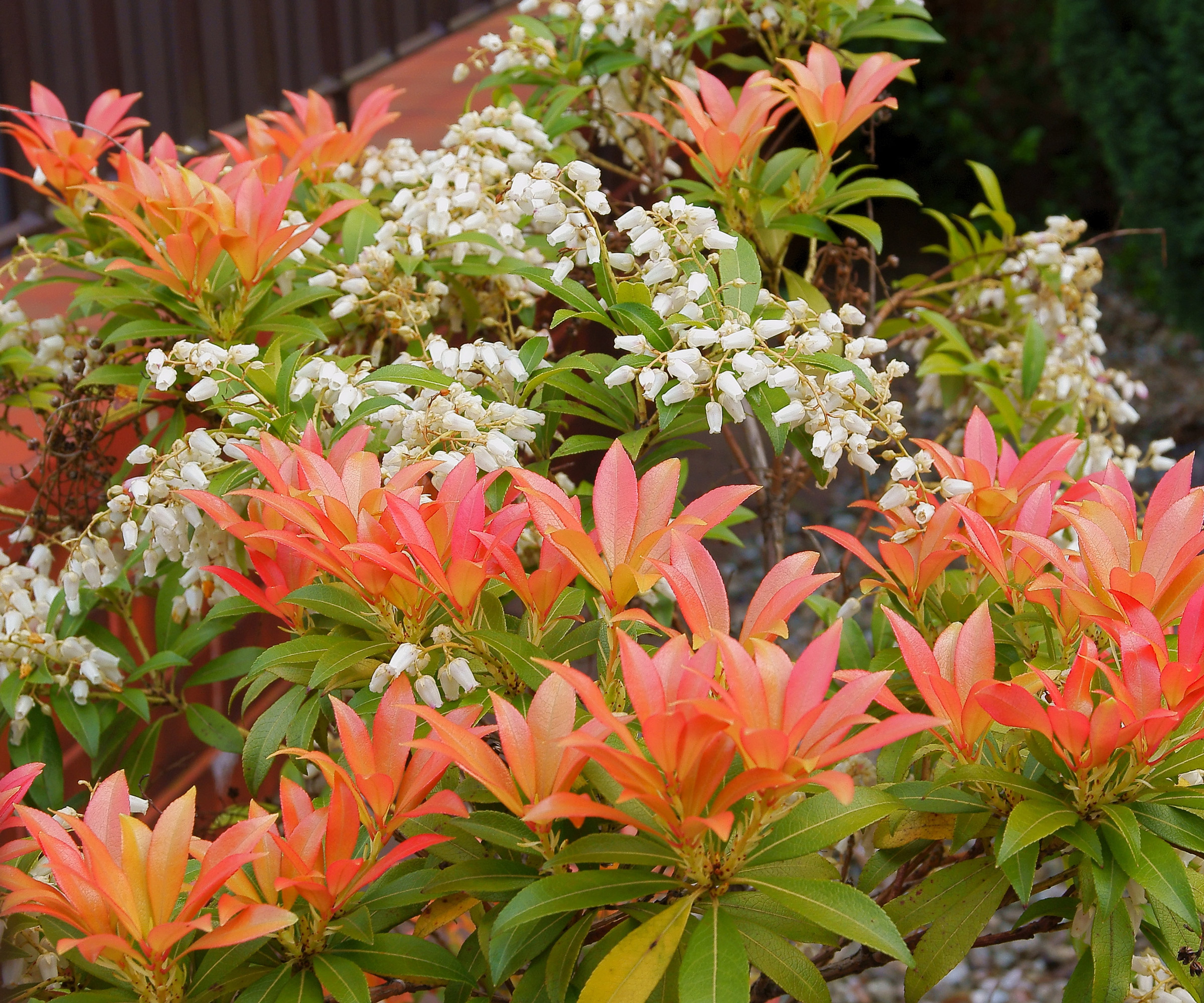
Pieris have a natural ability to develop into bushy, evenly balanced plants so minimal care is needed with shaping
How to make more pieris
For many garden plants, taking cuttings is the best way to create more plants for free. For others, you can divide plants to make more of them. But the simplest and most dependable way to make more pieris is by layering, which is a technique that encourages a new plant to develop while still attached to the parent. However, it is only possible to propagate new pieris in small numbers in this way. Here’s how to do it:
- In spring, choose a low-growing, pencil-thick branch, perhaps one that is resting on the ground. Where the branch touches the ground, scrape away the mulch, snip off leaves or side-shoots and press into the soil.
- Fix this branch in place with a bent piece of stout wire, a large stone or a half brick. Once it is secure, you can cover it with mulch and water well.
- By fall, roots will develop and the stem can be snipped, cutting between the new plant and the old one. Dig up the rooted layer and plant it somewhere else in the fall. Better still, wait until spring.

To propagate by layering, secure a section of stem just below the surface of the soil
Key problems and how to solve them
Pieris suffer from few pests and diseases, although one pest has become a problem in the last 20 years. The Japanese lacebug is a small insect whose larvae suck sap on the backs of pieris leaves. The result is a pale speckling of the upper surface of the foliage, which also tends to turn pale and sometimes develops a brown tint. Still, while the leaves may sometimes drop off, it is only occasionally that the plants suffer so much they die. Many gardeners simply learn to live with the problem, as often flowering is unaffected.
If you want to know how to grow pieris with the best chance of preventing this problem, there is a solution. Encourage birds (either by adding feeders or growing more plants for birds) and entice insect predators. Insecticides are available, but often kill beneficial insects as well as lacebugs.
Other minor pieris problems include scale insects and leaf spot, while dieback is usually caused by waterlogged soil.
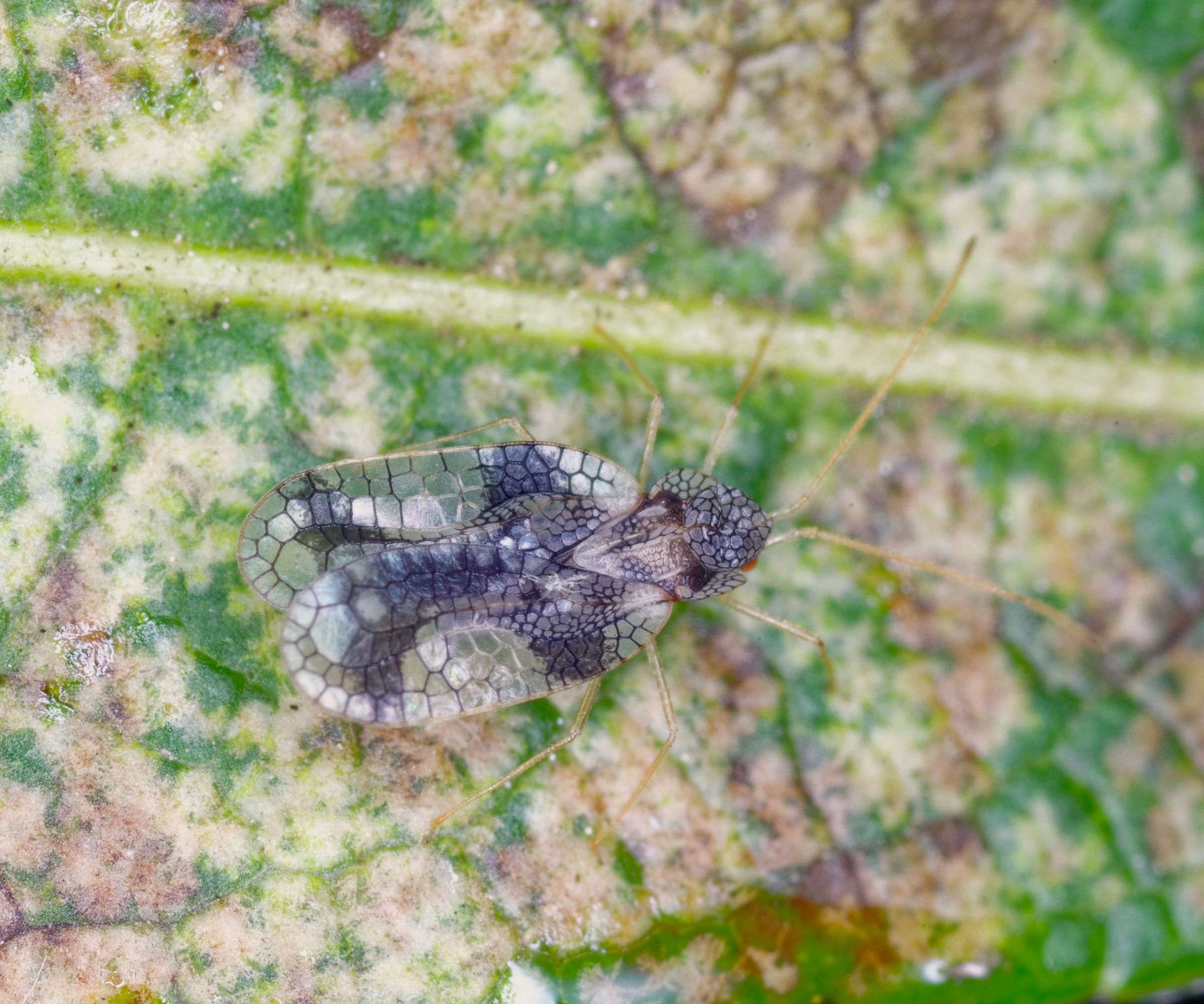
The lacebug causes brown speckling of the leaf surfaces
FAQs
Do I need to prune pieris?
Pieris do not need regular pruning, but they may require rejuvenation after severe damage or after being overshadowed by a neighboring tree or larger shrub. When you grow pieris they can, if necessary, be cut back hard with clean pruning shears and they will produce new shoots from old wood. If this proves necessary, spring is the time to do it. Be sure not to let your pieris dry out while it is trying to develop its new growth.
Can I grow pieris from seeds?
You can grow pieris from seeds, but success is not guaranteed. In late spring, scatter seeds thinly on the surface of 5in pots of fresh, lime-free potting mix. Cover with a dusting of potting soil, water in with a mister, place in a polythene bag and tie the top. Position in a bright, sheltered spot outside. After a month, seedlings should sprout. When 2-3in high, move into 3in pots to grow on before planting out.
There is an alternative if you are worried about seed sowing mistakes and you already have a mature pieris. Look around your yard and you may find tiny pieris plants growing in out-of-the-way corners. Each little plant looks like the shoot tip on a larger plant. In spring, these can be dug up and moved to a good site.
What is the best fertilizer for pieris?
Any fertilizer formulated for plants that dislike limey soil will be ideal. Fertilizer is rarely developed specifically for pieris, but any feed suitable for fertilizing rhododendrons and azaleas will give plants the boost they need.
Try Holly-tone, widely available online and in garden centers and DIY stores. Pieris in containers will appreciate a water-on fertilizer every month between spring and late summer. A feed for acid-loving plants (such as Miracle-Gro Azalea, Camellia, Rhododendron Soluble Plant Food, available from Amazon) is ideal.
Are pieris plants deer resistant?
If you are after deer-resistant plants, the good news is that both the native fetterbush (mountain pieris), and the Japanese pieris fit the bill. Experts at Rutgers University’s New Jersey Agricultural Experiment Station (NJAES) have rated both as ‘Rarely Damaged’. In fact, the native fetterbush (Pieris floribunda) is considered one of the most deer-resistant of all shrubs.
Pieris are offered both in garden centers and by mail order. In retail nurseries, garden centers and the garden departments of DIY stores, they are usually seen in spring when in flower. Plants may be offered in gallon containers, while specimen-sized options may come in larger containers. They are also sometimes stocked as large, balled and burlapped plants – dug up from the nursery with a large root system that retains the soil and the roots wrapped tightly in burlap.
As ever, a wider selection is offered by mail order, in sizes from one gallon to four gallons (the larger sizes can be expensive to ship). Some suppliers allow you to order online for delivery to local nurseries at planting time and this can work well. Use our quick links to find varieties that best suit your garden and planting needs.

Graham Rice is a garden writer who has won awards for his work online, and in books and magazines, on both sides of the Atlantic. He is a member of a number of Royal Horticultural Society committees and the recipient of the 2021 Garden Media Guild Lifetime Achievement Award. He gardened in Pennsylvania for 20 years, but has recently returned to his native England.